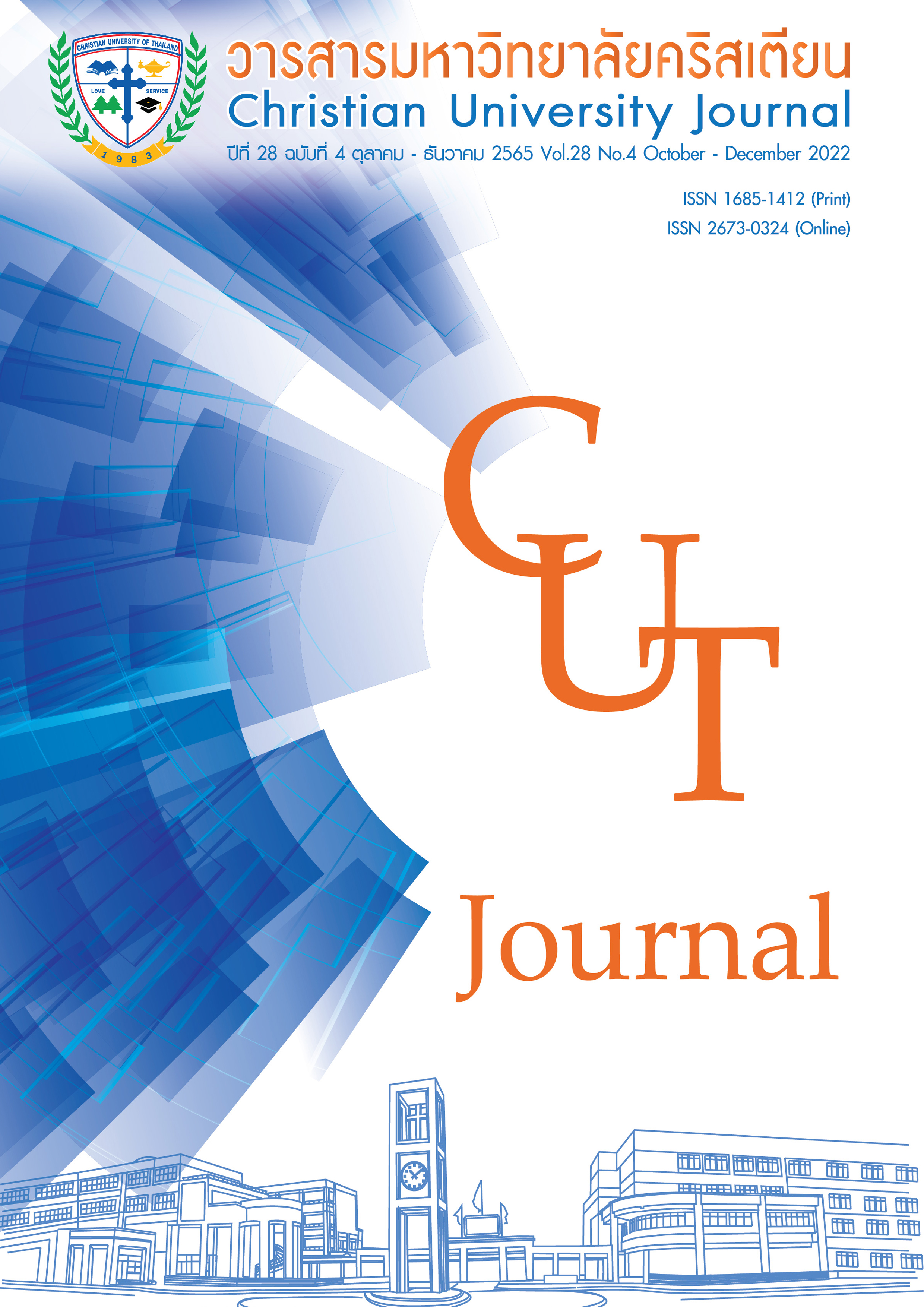Effects of Thai Hermit Exercise on Heart Rate, Blood Pressure, Stress and Quality of Life in Sedentary Elderly
Keywords:
Thai hermit exercise, Heart rate, Blood pressure, Quality of life, Sedentary elderlyAbstract
Sedentary elderly people are the group most affected by stress which leads to various diseases. Therefore, reducing the risk of stress and increasing the quality of life are important. The aim of this research is to observe the effects of Thai Hermit exercises on the heart rate, blood pressure, stress and quality of life in the sedentary elderly. There were 22 volunteers in the study, aged 60-75, divided into two groups. The experimental group received a Thai hermit’s exercise program of 60 minutes, 3 times a week for a period of 8 weeks. The control group did not exercise. Paired t-test and independent t-test statistics were used to analyze the data. A blood pressure monitor, self-assessment stress test, and quality of life questionnaire were used in the study. In the experimental group, after training for 4 weeks and 8 weeks, systolic blood pressure was significantly reduced (p<0.05). After 8 weeks of training, heart rate, stress reduction, and quality of life were statistically significant. There was no statistically significant difference between the control group and the experimental group. Comparing data on stress and quality of life across the two groups, the research revealed statistically significant differences. In conclusion, the study showed that the Thai Hermit’s exercises reduced stress, lowered the heart rate and systolic blood pressure to normal levels and improve quality of life in sedentary elderly people.
References
กรมพัฒนาการแพทย์แผนไทยและการแพทย์ทางเลือก กระทรวงสาธารสุข. (2556). ฤๅษีดัดตน ขยับกายสบายชีวี ด้วยการบริหารแบบไทยฤๅษีดัดตน 15 ท่า. กรุงเทพมหานคร: บริษัท โพสต์พับลิชชิ่ง จำกัด (มหาชน).
กิตติพันธุ์ อรุณพลังสันติ และนงนุช พลบูรณ์. (2554). ผลการเปรียบเทียบความสามารถในการทรงตัวของผู้สูงอายุ ระหว่างการออกกำลังกายแบบชี่กงและการออกกำลังกายแบบท่าฤๅษีดัดตน. วารสารมหาวิทยาลัยคริสเตียน, 17(1), 116- 125.
กัตติกา ธนะขว้าง และจันตนา รัตนวิฑูรย์. (2556). ผลของการรำไม้พลองมองเซิงเมืองน่านต่อสมรรถภาพทางกายและคุณภาพชีวิตด้านสุขภาพของผู้สูงอายุหญิงที่ไม่ได้ออกกำลังกายเป็นประจำ. พยาบาลสาร, 40(2), 148-161.
ปริยาภัทร สิงห์ทอง, ภักศจีภรณ์ ขันทอง, กัญญ์ณณัฐ เทพสุริยานนท์, และอรชร ดวงแก้ว. (2563). ผลของการออกกำลังกายฤๅษีดัดตนต่อการบรรเทาความรุนแรงของภาวะข้อเข่าเสื่อมระยะเริ่มต้นในผู้หญิงวัยกลางคน. วารสารการแพทย์แผนไทยและการแพทย์ทางเลือก, 18(1), 60-70.
ภักศจีภรณ์ ขันทอง, สุภารัตน์ สุขโท, ศุภรัตน์ พันธ์พรหม, ขวัญฤทัย แทนหอม, และวิศิษฐ์ชัย ระหาร. (2561). ผลทันทีของการฝึกฤๅษีดัดตนต่อความยืดหยุ่นของหลังในผู้สูงอายุ. วารสารวิจัยสาธารณสุขศาสตร์มหาวิทยาลัยราชภัฏอุบลราชธานี, 7(2), 108-114.
มูลนิธิสถาบันวิจัยและพัฒนาผู้สูงอายุไทย. (2559). สถานการณ์ผู้สูงอายุไทย 2559. นครปฐม: บริษัท พริ้นเทอรี่ จำกัด.
วารี วิดจายา, ธนารักษ์ วงษ์วัฒนพงษ์, และอมรพันธ์ อัจจิมาพร. (2562). ผลของการฝึกฤๅษีดัดตนประยุกต์ต่อสมรรถภาพทางกายในหญิงสูงวัยที่มีภาวะอ้วน. วารสารการแพทย์และวิทยาศาสตร์สุขภาพ, 26(3), 84-101.
วราภรณ์ แย้มมีศรี และปราณี จันธิมา. (2561). ผลของโปรแกรมการออกกำลังกายแบบรำวงย้อนยุคต่อความดันโลหิตในผู้สูงอายุโรคความดันโลหิตสูง. วารสารพยาบาลศาสตร์และสุขภาพ, 41(2), 58-68.
วีระพงษ์ ชิดนอก. (2552). การบริหารกายด้วยฤๅษีดัดตน. วารสารเทคนิคการแพทย์และกายภาพบำบัด, 21(3), 189-197.
วัลลภา ลีลานันทกุล, นารีวรรณ สมาน, ศตพร อิสาสะวิน, ศิริพร อบสุนทร, และสุวรรณา แม่นปืน. (2562). ผลของการบริหารร่างกายฤๅษีดัดตน (ท่าแก้โรคในอก) ต่อความดันโลหิต อัตราการเต้นของหัวใจสมรรถภาพหัวใจและปอดในผู้สูงอายุที่เป็นโรคความดันโลหิตสูงชนิดปฐมภูมิ. ธรรมศาสตร์เวชสาร, 19(2), 334-347.
วัลลภา ลีลานันทกุล เนตรชนก ชิณเกตุ ประดิษฐา ดวงเดช สุธามาศ บุตรัตน์ และสุวรรณา แม่ปืน. (2561). ผลของการบริหารร่างกายฤๅษีดัดตนท่าแก้โรคในอกต่อการขยายตัวของทรวงอก ความแข็งแรงของกล้ามเนื้อหายใจและสมรรถภาพของปอดในผู้ที่มีสุขภาพดีช่วงอายุ 50-90 ปี. วารสารการแพทย์แผนไทยและการแพทย์ทางเลือก, 16(2), 229-247.
สมาคมความดันโลหิตสูงแห่งประเทศไทย. (2562). แนวทางการรักษาโรคความดันโลหิตสูง ในเวชปฏิบัติทั่วไป พ.ศ. 2562. เชียงใหม่: ทริค ธิงค์.
สำนักส่งเสริมสุขภาพ กรมอนามัย. (2556). รายงานการสำรวจสุขภาวะผู้สูงอายุไทย ปี 2556 ภายใต้แผนงานส่งเสริมสุขภาพผู้สูงอายุและผู้พิการ. นนทบุรี: โรงพิมพ์วัชรินทร์ พี.พี.
สำนักงานสถิติแห่งชาติ. (2563). สถิติประชากรศาสตร์ ประชากรและเคหะ. สืบค้นจาก http://statbbi.nso.go.th/staticreport/page/sector/th/01.aspx
หทัยชนก หมากผิน, วรรณนิศา ธนัคฆเศรณี, ทิพย์สุดา บานแย้ม, สัตพร เจริญสุข, และทิพย์สิตา แก้วหนเสม็ด. (2563). ผลของการออกกาลังกายแบบฟ้อนไทยทรงดาประยุกต์ต่อคุณภาพชีวิตในผู้สูงอายุที่มีโรคความดันโลหิตสูงและเสี่ยงต่อการเกิดโรคหลอดเลือดสมอง. วารสารมหาวิทยาลัยคริสเตียน, 26(1), 28-41.
อมรรัตน์ นธะสนธิ์, ภักศจีภรณ์ ขันทอง, และอนัญญา เดชะคำภู. ผลการออกกำลังกายด้วยฤๅษีดัดตนต่อภาวะโภชนาการและคุณภาพชีวิตในผู้สูงอายุ. รามาธิบดีพยาบาลสาร, 26(1), 90-106.
อรวรรณ บุราณรักษ์ และวิชัย อึงพินิจพงศ์. (2556). ผลของการออกกำลังกายแบบฤๅษีดัดตน แบบชี่กง และแบบผสมผสานต่อความเครียด และคุณภาพชีวิต ในผู้หญิงที่ไม่ได้ออกกำลังกายเป็นประจำ. วารสารเทคนิคการแพทย์และกายภาพบำบัด, 25(3), 280-288.
Aekplakorn W, Stolk RP, Neal B, Suriyawongpaisal P, Chongsuvivatwong V, Cheepudomwit S, et al. (2003). The prevalence and management of diabetes in Thai adults: theinternational collaborative study of cardiovascular disease in Asia. Diabetes Care, 26(10), 2758–2763.
Buttagat V, Eungpinichpong W, Chatchawan U, Kharmwan S. (2011). The immediate effectsof traditional Thai massage on heart rate variability and stress-related parameters in patients with back pain associated with myofascial trigger points. Journal of Bodywork & Movement Therapies, 15(1), 15-23.
Di Luigi L, Sgrò P, Baldari C, Gallotta MC, Emerenziani GP, Crescioli C, et al. (2012). The phosphodiesterases type 5 inhibitor tadalafil reduces the activation of the hypothalamus-pituitary-adrenal axis in men during cycle ergometric exercise. American Journal of Physiology - Endocrinology and Metabolism Am J Physiol Endocrinol Metab, 302(8), E972–E978.
Faul F, Erdfelder E, Buchner A, and Lang, A.-G. (2009). Statistical power analyses using G*Power 3.1: Tests for correlation and regression analyses. Behavior Research Methods, 41, 1149-1160.
Feher J. (2017). Quantitative Human Physiology. (2nd edition). New York, NY: Academic Press.
Fu Q and Levine BD. (2013). Exercise and the autonomic nervous system. Handb Clin Neurol, 117, 147-160.
Galloza J, Castillo B, Micheo W. (2017). Benefits of Exercise in the Older Population. PhysMed Rehabil Clin N Am, 28(4), 659-669.
Hishikawa N, Takahashi Y, Fukui Y, Tokuchi R, Furusawa J, Takemoto M, Sato K, Yamashita T, Ohta Y, Abe K. (2019). Yoga-plus exercise mix promotes cognitive, affective, and physical functions in elderly people. Neurol Res, 41(11), 1001-1007.
Mcleod S. (2019). What does effect size tell you?. Retrieved from https://www.simplypsychology.org/effect-size.html
Takizawa C, Gemmell E, Kenworthy J, Speyer R. (2016). A Systematic Review of the Prevalence of Oropharyngeal Dysphagia in Stroke, Parkinson's Disease, Alzheimer's Disease, Head Injury, and Pneumonia. Dysphagia, 31(3), 434-441.
Downloads
Published
Issue
Section
License
Copyright (c) 2022 Christian University of Thailand

This work is licensed under a Creative Commons Attribution-NonCommercial-NoDerivatives 4.0 International License.



